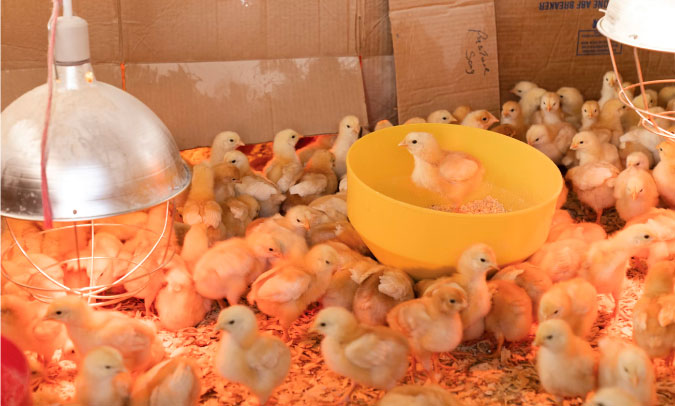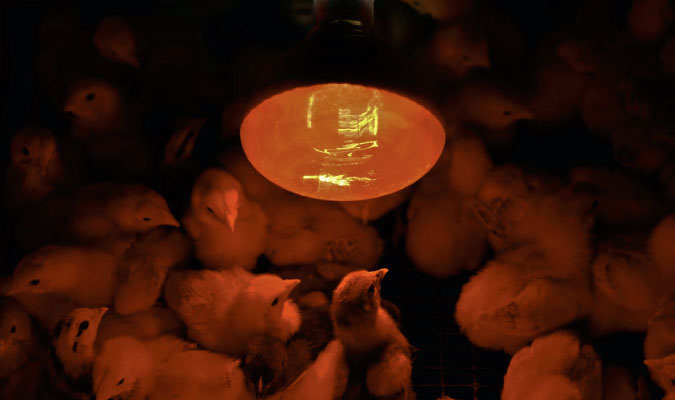Brooding chicks is an exciting and rewarding experience for backyard chicken enthusiasts, but ensuring their safety and well-being during this crucial stage is paramount.
In this blog post, we will explore three methods to safely and effectively brood chicks, with temperature requirements. Whether you’re a novice or a seasoned chicken keeper, these tips will help you learn how to brood chicks from day one.
How to Brood Chicks and Quail
Poultry and game bird producers realize that chicks must be kept warm or brooded during the first weeks of life. Surprisingly, improper brooding is one of the most common causes of stress in poultry flocks.
Three basic methods are used to brood chicks.
1. Spot Brooding – The chicks have localized heat source and access to a cooler, unheated area. The chicks determine their own heating needs by moving from hot to cold areas and vice versa.
2. Whole House Brooding – A large area around the brooders is warmed to the same temperature is called whole-house brooding. The chicks have no choice between warm and cool areas.
3. Partial‐House Brooding ‐ Partial‐house brooding is much like whole-house brooding since the total brooding area is warmed. To save energy, however, the brooding area is reduced to the minimum amount needed for the size of chicks. As the chicks grow, the brooding area is increased in accordance with their sizes. Good ventilation is essential with all brooding systems, especially partial‐house brooding.
Light the brooders 24 hours before the chicks hatch or arrive. Determine if the brooders are working properly, and adjust the temperature to 90 to 95 °F below the outer edge of the brooder (1 inch above the litter). In times of stress or vaccination reactions, increase brooder temperatures about 5 ° above the recommended temperature until the chicks recover.
Place an 18-inch-high, solid-type brooder guard around each brooder. Locate the guard 3 to 4 feet from the edge of the brooder. The guard prevents floor drafts and keeps chicks near the heat. In summer, enlarge the ring to keep chicks from getting too hot. Expand the guard a little each day (about 20 to 25 percent total area increase) until it is no longer needed after 7 to 14 days.
Corrugated cardboard makes an excellent brooder guard and can be discarded when it becomes soiled. In hot weather, hardware cloth or similar mesh material may be used instead of solid guard. Most of these guards are cleaned, disinfected, and reused.
Place an adequate number of feeders and waterers around each brooder. Provide at least two 1- 1-gallon waterers and two 12-inch or 18-inch chick feeders for every 100 chicks. Feed placed on a few feeder lids or egg flats under each brooder encourages the chicks to start eating sooner.
Sprinkle a pile of feed on each lid before placing chicks under the brooder. Remove lids when all feed is eaten or after 4 to 6 days.
Place long waterers or feeders in the brooding area, pointing toward the heat source. If placed parallel to the brooder guard, small chicks may be prevented from returning to the warmth. (At 1 day of age, they have not learned they sometimes have to go around a long object to get back to the warmth.) Placing feeders in a “wagon spoke” fashion also insures that a section of each feeder is always in a comfort zone. Locate the inner end of the feeder under or slightly outside the outer edge of the brooder or hover. Never place all the waterers and feeders directly under the brooder. The area under the brooder must be kept clear for brooding the chicks.
The day-old chick’s temperature is about 3 °F below that of an adult’s. Its body temperature starts rising about 4 days of age and reaches its maximum at 10 days. The chick needs time to develop temperature control (2 to 4 weeks). As the chick grows older, the downy coat is replaced with feathers, and brooder temperature must be reduced according to the temperature schedule.
Brooding Temperature Schedule |
||
| Age, in Days | Brooder Temperature (F) | |
| Summer | Winter | |
| 1 – 7 | 90 | 95 |
| 8 – 14 | 85 | 90 |
| 15 – 21 | 80 | 85 |
| 22 – 28 | 75 | 80 |
| 29 – 35 | 70 | 75 |
| 36 – Market | 70 | 70 |
Under this brooding schedule, the brooding temperature is reduced 5 °F each week. At 5 weeks of age, chicks maintain their own body temperatures if the room temperature is kept near 70 degrees.
Use lower brooding temperatures during warm months. Most poultry houses are not tight enough to maintain these temperatures constantly in winter. Insure adequate warmth in winter by using the higher brooding temperature; when cold nights cool the house, chicks are likely to have enough warmth.
In contrast to what many think, the most frequent error observed when brooding in the South is overheating rather than too little heat. Many producers need to learn proper brooding to reduce losses.
Check the comfort of the chicks several times each day, especially in the evening. Make adjustments to maintain chick comfort. Contented peeping and even distribution of chicks around and under the brooder indicate comfortable conditions. If the chicks chirp and huddle to one side of the brooder, there is a draft. When the temperature is too cold, the chicks chirp sharply and huddle together under the brooder. If the chicks move away from the brooder, pant, and are drowsy, the temperature is too warm.
With steadily increasing energy costs, a strong emphasis must be placed on sound brooder management and operation. Some tips for conserving energy are listed.
• Use the correct brooder height, as recommended by the brooder manufacturer. A higher brooder adjustment increases fuel usage, while lower brooder adjustment increases the danger of igniting flammable litter and burning the chicks. Maintain a minimum clearance of 5 to 6 inches over the chicks’ backs.
• Use dry litter material for brooding. Additional energy is needed to evaporate moisture.
• Check the accuracy of brooder thermostats and thermometers to ensure proper heat for the chicks.
• Solid brooder guards keep the heat closer to the brooder.
• Place brooders near the center of the house. This reduces heat loss through walls and prevents drafts.
• Frequently clean burner orifices, adjust pilot lights and check for proper gas line pressure.
• Brood the maximum number of chicks under each brooder, but do not overcrowd.
• Shut off half the brooder pilot lights when all the brooders are no longer needed. The best practice is to turn off every other brooder. The remaining brooders help prevent serious problems if internal house temperatures drop suddenly.
Brooding Chickens and Quail PDF
By Tom W. Smith, Jr., Ph.D., Emeritus Professor of Poultry Science, Mississippi State University
Mississippi State University does not discriminate on the basis of race, color, religion, national origin, sex, age, disability, or veteran status.
Information Sheet 1338
Extension Service of Mississippi State University, cooperating with U.S. Department of Agriculture. Published in furtherance of Acts of Congress, May 8 and June 30, 1914. Ronald A. Brown, Director
You May Also Be Interested In:
- 40+ Free Chicken Coop Plans: Learn How To Build Now!
- Chicken Coop Design: Meeting Your Chickens’ 6 Basic Needs
- Top 15 Basic Supplies You Need to Brood Chicks the Right Way
- 3 Methods for Brooding Chicks, with Temperature Requirements









COMMENTS(5)
Good article. Raising chicks is a great way to build a flock or, as we do, raise a batch of meat birds for the freezer.
We just received 32 day-old chicks in the mail. We put them into a 100 gallon stock tank with newspaper on the bottom, covered with an inch of straw. We mounted an infrared brooder light at one end of the tank that sits about a foot above the bottom. The chicks started out spending most of the time under the brooder light, moving away only for food and water. Some sleep a little farther away than others, which tells me the temperature is pretty good and all the chicks can find their ‘sweet spot.’ Every day I coax the chicks away from the heated end using a broom, and add a fresh layer of straw to cover the poop. In a week, I will move the brooder lamp to the other end of the stock tank and the chicks will follow. I can then clean out the poopy straw end and put a fresh layer down and be good for another week. Once the chicks are large enough and it is warm enough outside, they will be moved to my chicken tractor for growing out. We raised some great tasting Cornish-cross birds last year and are looking forward to this year’s harvest.
I got a supply of 100 broilers on Friday 20, January 2017. I maintained the standard temperature of 35 degrees Celsius and today is the forth day; the chicks are doing great
I want know requament space for brooding chicks
I want to know the space for brooding chicks
i have day old to one week country chicks, they are rapidly dying day after day and leave lumps on their body back side . few of them are surviving but most of them are dying . Please leave your suggesions .